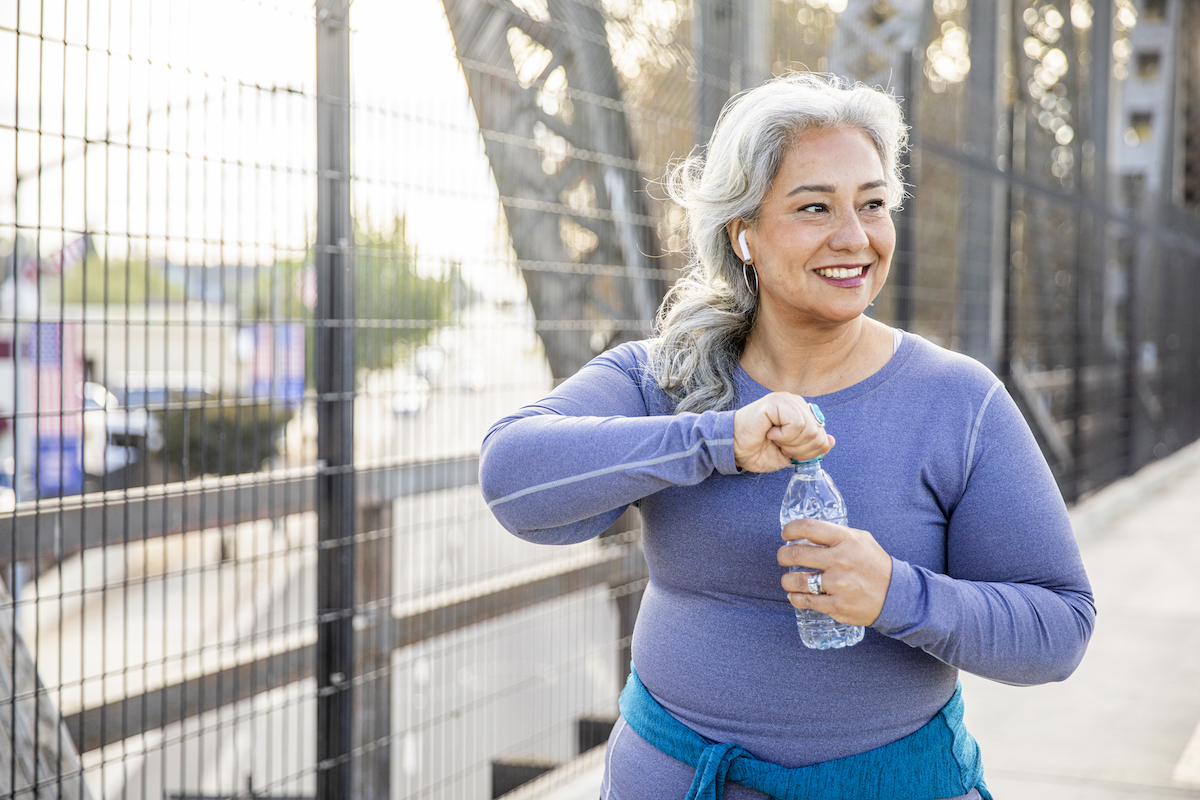7 Ways to Manage Urinary Incontinence That Really Work
These tips can put an end to bladder leaks.

Maybe it’s just a couple of drops when you sneeze or a little dribble when you laugh. Or maybe it’s an uh-oh moment when you’re pretty sure you won’t make it to the bathroom in time. However it plays out, urinary incontinence is an inconvenience, to say the least.
And if you’re over 65, there’s a pretty good chance it’s a problem for you. According to the Centers for Disease Control and Prevention, nearly 44 percent of older Americans living at home report urinary leakage, from slight or moderate to severe.
The worst thing you can do: not talk about it.
“Many people suffer in silence,” says Debra Fromer, M.D., associate professor of urology and chief of female pelvic medicine and reconstructive surgery at Hackensack Meridian Health in New Jersey. “They’re often unwilling to open up to their doctor about urinary incontinence, and that’s too bad. There are so many good therapies available.”
So if you think you’ve got urinary incontinence (UI), speak up. Not sure? “It’s pretty simple: Urinary incontinence is the unwanted leakage of urine,” Dr. Fromer says.
There are several reasons you might have it, but the outcome is pretty universal: You worry about having leaks and are uncomfortable when you do. That fear may keep you from doing things you really enjoy.
Beyond having an unresolved health issue, you may find yourself dealing with social isolation, depression, or other mental health issues. Incontinence is even associated with falls, which could slow you down even more or land you in the hospital or a nursing home.
The bottom line: Whether it’s a little dribble or a mad dash to the bathroom, it should be taken seriously. Here’s what you need to know.
Add SilverSneakers to your wellness routine! Classes and events are happening daily at participating gyms, online through SilverSneakers LIVE and at community centers near you. Activate your free online account to get started.
Urinary Incontinence 101
There are many kinds of urinary incontinence, explains Dr. Fromer, but the two most common ones are known as stress incontinence and urge incontinence.
Stress incontinence is a little leak or dribble when you sneeze, cough, exercise, or laugh. It happens most commonly because of weakness in the muscles that support your urethra, the tube that carries urine from your bladder and out of your body when you pee.
“Stress incontinence is most common in women who have had babies by vaginal delivery,” Dr. Fromer says. “This is due to the weakening of the muscles around the urethra during delivery.” And though you might have had your kids decades ago, this is one side effect you may be feeling now.
Other contributors to stress incontinence include aging, menopause, and a lifetime of activity. “As we get older, our muscles weaken,” Dr. Fromer says. “The bladder and the urethra are composed of muscle too, and these muscles are no exception.”
Urge incontinence, on the other hand, is another name for an overactive bladder. If you’ve ever had to make a mad dash to the bathroom (and didn’t make it there on time), you might have urge incontinence. It happens because of a spasm of your bladder—when the muscles squeeze, or contract, at the wrong time, whether your bladder is full or not.
“Urge UI is more common in women,” says Dr. Fromer, “though men catch up later in life.”
Some people experience urge incontinence when they hear running water or after they’ve had lots of fluids. Certain medications may play a part as well.
“A lot of older people take water pills, or diuretics, for high blood pressure,” Dr. Fromer says. “They make your body create more urine, and the more urine you make, the more likely it is that you could leak urine if you already have bladder problems. Diuretics don’t necessarily cause incontinence, but they can make it worse.”
Caffeinated beverages such as coffee, tea, or cola can also contribute to urge UI.
Whatever the type, UI often happens as a result of age-related changes to your urinary system, such as decreased bladder capacity, increased urine production at night, lower estrogen levels in women, and an enlarged prostate gland in men. But that doesn’t mean it’s something you just have to live with.
7 Strategies for Taking Charge of Urinary Incontinence
Take control of UI—don’t let it control you. Here are seven effective strategies you should know. Talk to your doctor to find out which ones might be right for you.
Strategy #1: Pelvic Floor Contractions, or Kegels
Your pelvic floor is like a hammock of muscles that hold your bladder, urethra, and other nearby organs in place. By keeping it strong and healthy, you can decrease problems with UI.
Your best bet: Kegel exercises, which are effective for both stress and urge incontinence. Here’s a quick how-to for women:
- First, locate your pelvic floor muscles by imagining that you’re trying to stop a urine flow mid-stream.
- Next, quickly tighten those muscles, lifting them up and holding for one to two seconds before releasing them back down. Do five reps of these quick contractions.
- Finally, do the same thing but hold the contraction longer (up to 10 seconds). The ultimate goal is to hold for 10 seconds, then rest for 10 seconds, and repeat this pattern a few times.
- Do your Kegel exercises three times throughout the day, aiming for 10 repetitions total each time.
For men, the instructions are slightly different:
- Squeeze and draw in the muscles around your anus, as if you’re trying to stop passing gas. The movement should be from the inside—don’t tighten your buttocks. (Tip: Your scrotum should lift.)
- Hold for 8 to 10 counts.
- Relax for eight seconds, then repeat eight more times.
- Aim to do this exercise three times a day.
Having trouble getting the hang of it? Don’t worry—lots of people do at first. “Sometimes it’s difficult identifying exactly where those muscles are,” Dr. Fromer says. “A good solution might be to see a physical therapist specializing in incontinence who can help you with more advanced techniques.”
You can ask your primary care physician for a recommendation, or visit pelvicrehab.com to find a pelvic floor specialist near you.
Strategy #2: Healthy Lifestyle Changes
The little things you do every day can play a big part in your health, including your urinary health. A few things to consider:
- Lose excess weight. Shedding a few pounds can improve your symptoms of UI. In one study, overweight women who lost between 5 and 10 percent of their body weight experienced far fewer episodes of urine leakage.
- Stay active. Even if you’re worried about leaking, get moving anyway. Studies show that a sedentary lifestyle puts you at risk of UI, but walking and other moderate activities can help prevent or improve your symptoms
- Try yoga. Ongoing research at the University of California, San Francisco has shown that women completing a special three-month program of pelvic floor yoga report, on average, a 76 percent decrease in the frequency of their leaks
More research is needed to confirm the benefits of yoga for UI, but there’s no harm in giving it a try. Do a Google search for an in-person or online class specializing in pelvic floor yoga.
Subscribe to our newsletter
It's quick and easy. You could be one of the 13 million people who are eligible.
Already a member? Click to discover our 15,000+ participating locations.
Follow Us
Strategy #3: Medication
There are no approved medications to treat stress incontinence, but for urge incontinence, your doctor may recommend these options:
- Anticholinergics, such Vesicare or Enablex, which block the nerve signals that tell your bladder to contract. This takes away the urge to pee.
- Beta-3 agonists, such as Myrbetriq, which relax your bladder muscles and increase the amount of urine your bladder can hold.
“As with any medications, there may be side effects with drugs used to treat urge incontinence,” cautions Dr. Fromer. “But they generally offer improvement of incontinence in about 70 percent of patients.” The most common side effects of anticholinergics are constipation and dry mouth. For beta-3 agonists, the most common side effects are nausea, diarrhea, constipation, dizziness, and headaches.
Strategy #4: Urethral Bulking
If you have stress incontinence, your doctor may inject a bulking agent into your urethra, building up the thickness of the wall of the urethra and making the opening smaller. This is done in the doctor’s office, typically with a local or regional anesthetic.
While it’s effective in about half of patients (who see about a 50 percent improvement), the procedure usually has to be repeated later on. As always, a conversation with your doctor is the first step in finding out if it’s right for you.
Strategy #5: Surgery
For women with stress incontinence, an operation can often help. One type is the “mid-urethral sling” for women; for men, an option is an artificial urinary sphincter or a male sling. These devices reposition the urethra to help you hold your urine better.
All of these procedures are performed in the hospital or at a surgery center, and patients can often be discharged the same day. “We generally see success rates of 85 to 90 percent with patients undergoing surgery for stress urinary incontinence,” Dr. Fromer says.
Strategy #6: Botox
Botox is used for more than erasing wrinkles—it’s also an effective treatment for UI. “With urge incontinence, your bladder muscle is involuntarily contracting,” Dr. Fromer explains. “So an injection of Botox can relax it by affecting the nerves that supply those muscles.”
It’s a quick procedure done in your doctor’s office under local anesthesia. You’ll receive a series of injections into the muscle of your bladder through a tiny needle. The injection itself takes five minutes or less and produces impressive results: About 75 percent of patients report significant improvement in their overactive bladder symptoms.
Strategy #7: Sacral Neuromodulation
At the base of your spine are your sacral nerves, which send messages to and from your brain to regulate the way your bladder works. Sometimes, though, there’s a miscommunication that can lead to an overactive bladder. When that happens, your doctor may suggest a procedure called sacral neuromodulation.
“It’s similar to a pacemaker but for your bladder,” Dr. Fromer says. “We implant a battery under the skin of your buttocks that sends continuous electrical impulses to the nerves that supply your bladder. It’s effective in about 80 percent of patients with urge incontinence.”
Activate Your FREE SilverSneakers Online Account
Get hundreds of free SilverSneakers On-Demand videos and stay in touch with us by creating your free online account. You don’t have to be a SilverSneakers member to get on-demand workout videos, health and fitness tips from SilverSneakers, and more.
SilverSneakers members can go to thousands of nationwide gyms and fitness locations, plus take SilverSneakers LIVE online classes led by specially trained instructors and designed for all fitness levels and abilities – at no additional cost. If you have a Medicare Advantage plan, it may include SilverSneakers. Check your eligibility here.
Already a member? Get your SilverSneakers member ID, search for locations near you, and all the health and wellness resources you need by logging in to your online member account here.





